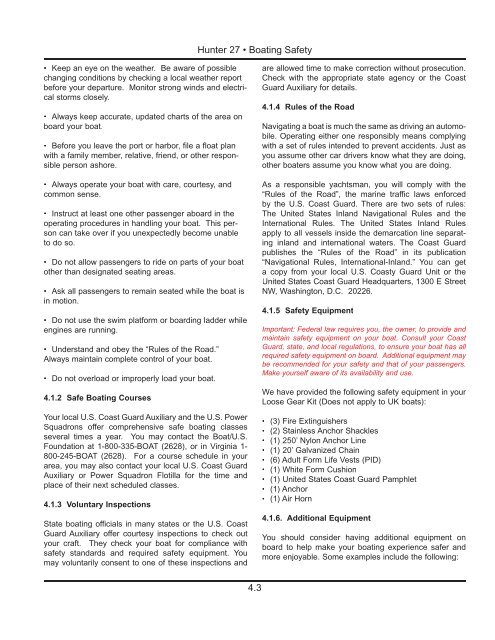27 Operator's Manual.. - Marlow-Hunter, LLC
27 Operator's Manual.. - Marlow-Hunter, LLC
27 Operator's Manual.. - Marlow-Hunter, LLC
Create successful ePaper yourself
Turn your PDF publications into a flip-book with our unique Google optimized e-Paper software.
<strong>Hunter</strong> <strong>27</strong> • Boating Safety<br />
• Keep an eye on the weather. Be aware of possible<br />
changing conditions by checking a local weather report<br />
before your departure. Monitor strong winds and electrical<br />
storms closely.<br />
• Always keep accurate, updated charts of the area on<br />
board your boat.<br />
• Before you leave the port or harbor, file a float plan<br />
with a family member, relative, friend, or other responsible<br />
person ashore.<br />
• Always operate your boat with care, courtesy, and<br />
common sense.<br />
• Instruct at least one other passenger aboard in the<br />
operating procedures in handling your boat. This person<br />
can take over if you unexpectedly become unable<br />
to do so.<br />
• Do not allow passengers to ride on parts of your boat<br />
other than designated seating areas.<br />
• Ask all passengers to remain seated while the boat is<br />
in motion.<br />
• Do not use the swim platform or boarding ladder while<br />
engines are running.<br />
• Understand and obey the “Rules of the Road.”<br />
Always maintain complete control of your boat.<br />
• Do not overload or improperly load your boat.<br />
4.1.2 Safe Boating Courses<br />
Your local U.S. Coast Guard Auxiliary and the U.S. Power<br />
Squadrons offer comprehensive safe boating classes<br />
several times a year. You may contact the Boat/U.S.<br />
Foundation at 1-800-335-BOAT (2628), or in Virginia 1-<br />
800-245-BOAT (2628). For a course schedule in your<br />
area, you may also contact your local U.S. Coast Guard<br />
Auxiliary or Power Squadron Flotilla for the time and<br />
place of their next scheduled classes.<br />
4.1.3 Voluntary Inspections<br />
State boating officials in many states or the U.S. Coast<br />
Guard Auxiliary offer courtesy inspections to check out<br />
your craft. They check your boat for compliance with<br />
safety standards and required safety equipment. You<br />
may voluntarily consent to one of these inspections and<br />
are allowed time to make correction without prosecution.<br />
Check with the appropriate state agency or the Coast<br />
Guard Auxiliary for details.<br />
4.1.4 Rules of the Road<br />
Navigating a boat is much the same as driving an automobile.<br />
Operating either one responsibly means complying<br />
with a set of rules intended to prevent accidents. Just as<br />
you assume other car drivers know what they are doing,<br />
other boaters assume you know what you are doing.<br />
As a responsible yachtsman, you will comply with the<br />
“Rules of the Road”, the marine traffic laws enforced<br />
by the U.S. Coast Guard. There are two sets of rules:<br />
The United States Inland Navigational Rules and the<br />
International Rules. The United States Inland Rules<br />
apply to all vessels inside the demarcation line separating<br />
inland and international waters. The Coast Guard<br />
publishes the “Rules of the Road” in its publication<br />
“Navigational Rules, International-Inland.” You can get<br />
a copy from your local U.S. Coasty Guard Unit or the<br />
United States Coast Guard Headquarters, 1300 E Street<br />
NW, Washington, D.C. 20226.<br />
4.1.5 Safety Equipment<br />
Important: Federal law requires you, the owner, to provide and<br />
maintain safety equipment on your boat. Consult your Coast<br />
Guard, state, and local regulations, to ensure your boat has all<br />
required safety equipment on board. Additional equipment may<br />
be recommended for your safety and that of your passengers.<br />
Make yourself aware of its availability and use.<br />
We have provided the following safety equipment in your<br />
Loose Gear Kit (Does not apply to UK boats):<br />
•<br />
•<br />
•<br />
•<br />
•<br />
•<br />
•<br />
•<br />
•<br />
(3) Fire Extinguishers<br />
(2) Stainless Anchor Shackles<br />
(1) 250’ Nylon Anchor Line<br />
(1) 20’ Galvanized Chain<br />
(6) Adult Form Life Vests (PID)<br />
(1) White Form Cushion<br />
(1) United States Coast Guard Pamphlet<br />
(1) Anchor<br />
(1) Air Horn<br />
4.1.6. Additional Equipment<br />
You should consider having additional equipment on<br />
board to help make your boating experience safer and<br />
more enjoyable. Some examples include the following:<br />
4.3

















